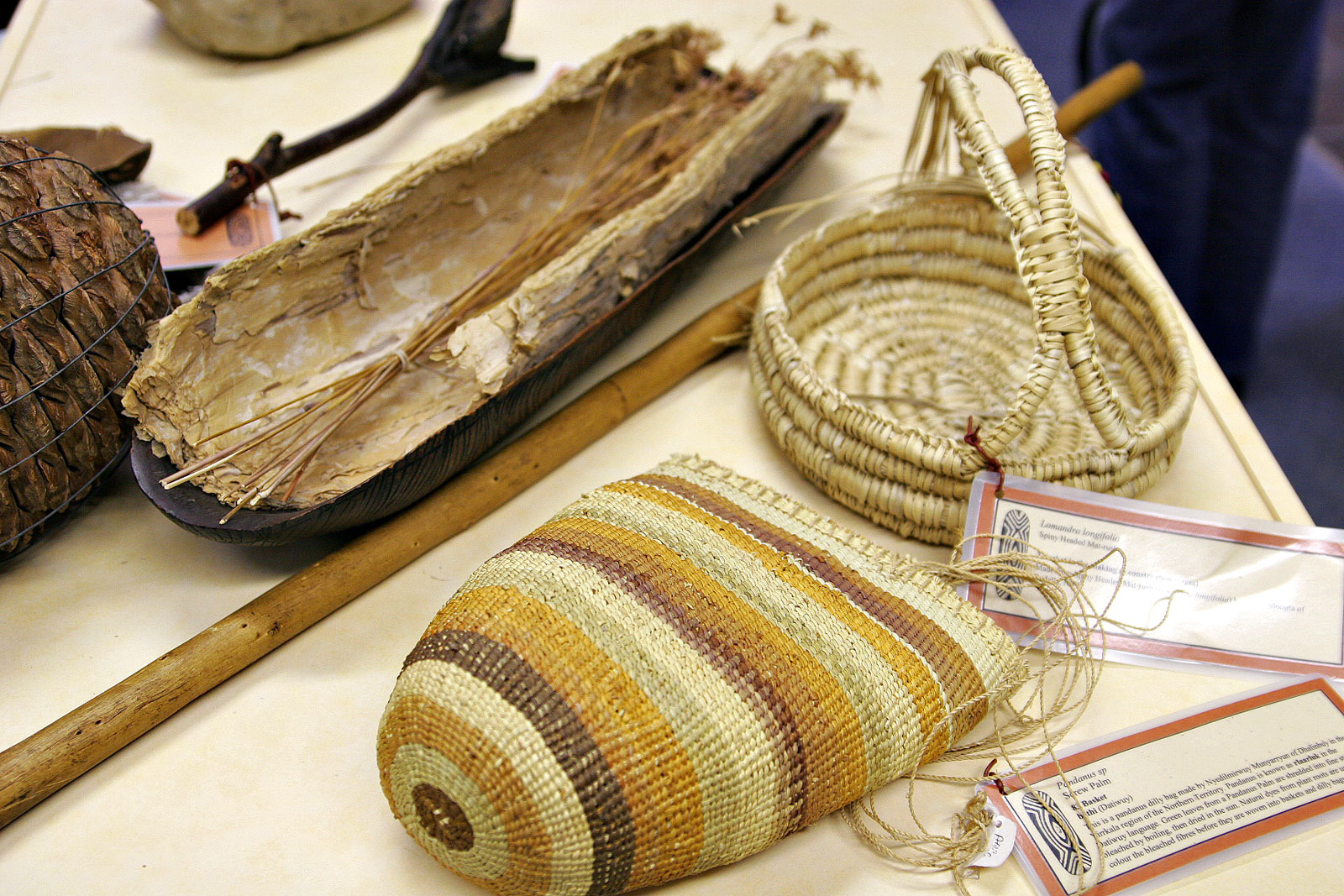- Australian Aboriginal fibrecraft
Australian Aboriginal fibrecraft refers to the various ways
Australian Aborigines created fibres traditionally. Materials used depended on where the people lived in Australia.Bark
thumb|right|250px">
Baskets were often made from twisted bark fibresBark was used by many people across the continent. This technology is still used today to produce baskets, which are particularly popular in the tourism industry.Kurrajong bark is a popular bark, as is the bark ofriver wattle s,sand fig s,banyan s,burney vine s andpeanut tree s.In the north, the more tightly woven styles were made, whereas in the south, a looser stringed bag, popularly known as a
dilly bag was made.Hair
Hairstring was an important
textile traditionally made byAustralian Aborigines .People, particularly the women, cut their
hair regularly usingquartz orflint knives . This hair was never wasted. It was rolled on the thigh and then spun into long threads of yarn. It was then plaited to about the thickness of 8 ply wool.Purposes for the string were manifold. These included making the head ring for resting the coolamon,
headband s to keep the hair off the face,spear -making (securing the head to the shaft), and even balls for ball games.A general-purpose belt was made of the string, from which things could be hung, such as small game like
goanna s in order to free the hands on long walks and hunts.] , which can mean sexual abuse, or having sex when she is not ready.
Among some tribes, adults wore a
loincloth -like pubic covering, which also hung from the waist belt. This was made either of the string itself, or of other material, includingpaperbark . In theKimberley region of Western Australia , the men worepearl shells as a pubic covering, which they call "Riji " [ [http://www.tribalmania.com/LONKA%20LONKA.htm Aboriginal Lonka Lonka Pearl Shell Pendant, Pubic Covers From Kimberly (Tribalmania.Com) ] ] , and which are considered extremely sacred.The string could be died various shades using dyes such as ochre.
Some string was only worn for
ceremony , such asskirt s worn by the women.tring games
make over 200 separate string figures. Each one involved complicated movements of her fingers and thumbs. She was able to remember the correct sequence of finger movements for nearly every figure she made, with only an occasional mistake which she quickly corrected. As she made each figure she gave it a name. Some examples included "dangurang" — a lobster, "bapa" — lightning, "matjur" — an ibis flying into a tree and "gapu" — the ripples on a pool. [ "Aboriginal Technology: Fibrecraft", Barlow, Alex, 1994, Macmillan Education Pty Ltd, p 6.]
The
Bangarra Dance Theatre 's 2005 production of CLAN incorporated traditional desert string games into one of their performances, creating intricate patterns as they thread themselves through long, elastic strings. [ [http://www.bangarra.com.au/diary/clan2006-set.html Bangarra Dance Theatre: Clan ] ] , [ [http://www.smh.com.au/articles/2004/06/15/1087244911921.html?from=storyrhs Graceful spin on a life's web - Arts - www.smh.com.au ] ]Grasses
Grasses were combined with the hair to create a tougher fibre. This varied depending on the area in Australia. In the arid areas, it was
spinifex , whereas in theTop End , it was palms such aspandanus .Pandanus and sand-palm are used in areas such as the Daly River region and Arnhem Land to weave carry baskets, dilly string bags, wall hangings, floor mats and fish-nets. The women of Peppimenarti and Oenpelli are famous for such weaving, however each community has their own distinct styles and techniques.
External references
* [http://www.janesoceania.com/australian_aboriginal_anthropology/index1.htm Australian Aboriginal Anthropology]
* [http://aboriginalart.com.au/culture/arrernte4.html Arrernte Dictionary]
* [http://www.virginia.edu/kluge-ruhe/newsletter/News0601wb.pdf Aboriginal Art Circular]
* [http://www.bonhamsandgoodman.com.au/lot_details.php?lot=14231 Alice Nampitjimpa artwork]
* [http://www.ozoutback.com.au/postcards/postcards_forms/abor_craft_2/Source/12.htm man making hairstring]
Wikimedia Foundation. 2010.

